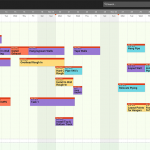Good data, when harnessed, enables better decisions and can dramatically simplify project management. At the same time, collecting and accessing high-quality data has long been a challenge in the AEC industry.
Business leaders in construction are often required to make critical decisions based on limited supporting data. While this is sometimes unavoidable, new technologies aim to make this a thing of the past.
Here are five things business leaders can do to refine their project management strategies through the use of data.
1. Capture More Data
The more data, the better. Standardize business processes to minimize the use of customized, one-off solutions and spreadsheets. This will also produce standardized and well-structured data.
Moving from analog to digital will amplify these benefits. Analog data can’t easily be used in the digital world, and often lacks consistent structure, making it cumbersome to use even if someone takes the time to put it in a digital format. Look for systems that offer the benefits of analog in a digital format.
2. Ensure Data Quality
All the data in the world won’t help if it’s inaccurate. Ensure data quality through the following steps.
First, automate data collection wherever possible. New technologies like sensors, wearables, mobile devices and drones are vastly expanding the possibilities when it comes to data capture.
Second, get data straight from the source. Don’t collect it and make it someone’s job to enter it into a system. Not only does this make for a lot of unnecessary work, it also opens up the possibility of introducing transfer and interpretation errors and it reduces people’s level of concern in the accuracy of their data because they feel disconnected from it and less personally responsible.
Third, enable community validation if possible. The more people who see the data, the more likely errors are to be caught and fixed. This helps to flag errors and get them corrected.
Finally, incentivize accurate data reporting by making sure everyone derives benefits from it. Use the data to eliminate steps that teams would otherwise have to perform, or give them new insights that can inform their decisions.
3. Make Data Accessible
Good data isn’t very helpful if it’s all stored in different places. Making it accessible is key.
First, look at storing data in the cloud. This makes data readily accessible and provides commercial-grade server redundancy, data backups and security that are often lacking with private hosting.
Second, seek out software applications able to integrate and share data with other applications. Software integrations in construction are relatively new, so many applications are still developing them. But do make sure that it factors high on their development roadmap.
4. Invest in Data Visualization
Dashboards enable data visualization through different lenses. Without them, it’s difficult to make sense of data and draw any real conclusions from it.
Just like the dashboard in an airplane or a car, business dashboards need to present information that’s clear, concise and actionable. Here are eight things to look for in a dashboard:
- Fresh, actionable data. Data latency should match or better the decision cycle.
- Dynamic data that reflects the current state and shows how it’s changing.
- Carefully selected metrics that reveal and magnify issues to focus on.
- Comprehensive coverage without any blind spots.
- Interactive filtering and drill-down capability to zero in on areas of interest and understand driving factors.
- Intuitive presentation that conveys information at a glance.
- Shareable information that the entire team can distribute and use when needed.
- Timely alerts that can be set to prompt the team when the data shows something designated as important.
5. Develop a Data-Driven Culture
It’s important to instill an appetite for data in the organization so that people are encouraged to continually look for new sources of data and ways to apply it. A data-driven culture seeks out ways of using data to inform decisions, highlights good results, defines success metrics and starts measuring them to gauge performance.
When people directly benefit from providing accurate data, more care is taken to ensure that the data is good. With higher-quality data and more organizational emphasis on its value, a team will be able to make better, more informed decisions. As the team sees the benefits of the data they collect, they’ll become increasingly invested in its accuracy, analysis and ongoing development.
(This article first appeared in Construction Executive)










